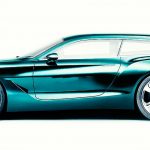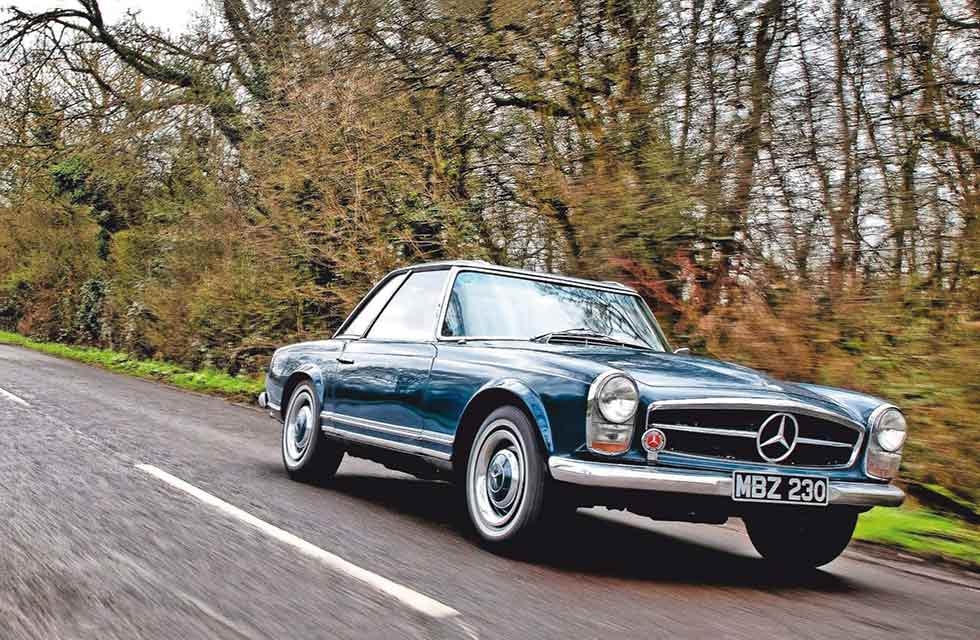
Merc SL – dream or dull? There’s not a bad aspect – the Pagoda carries its years lightly’ Driving a W113 SL is a decades-long dream for Simon Dodds. Will the sixties two-seater be the car he imagined? Words Emma Woodcock. Photography Neil Fraser.
The List – Your dream drive made real Reader Simon Dodds enjoys an elegant drive in a Mercedes-Benz ‘Pagoda’
‘Even prettier than I remember’ – reader drives his dream Merc SL
Stocklund Square car park in Cranleigh is a normal place to leave a perfectly normal car. Yet today, standing in the quietest corner, something abnormal catches the eye. Pert yet balanced, ringed with chrome but never excessive, the Paul Bracq lines of the Mercedes-Benz 230SL ‘Pagoda’ W113 have Drive-My/EN user-reader Simon Dodds entranced. This is one of his dream cars, and he’s about to slip behind the wheel for the first time.
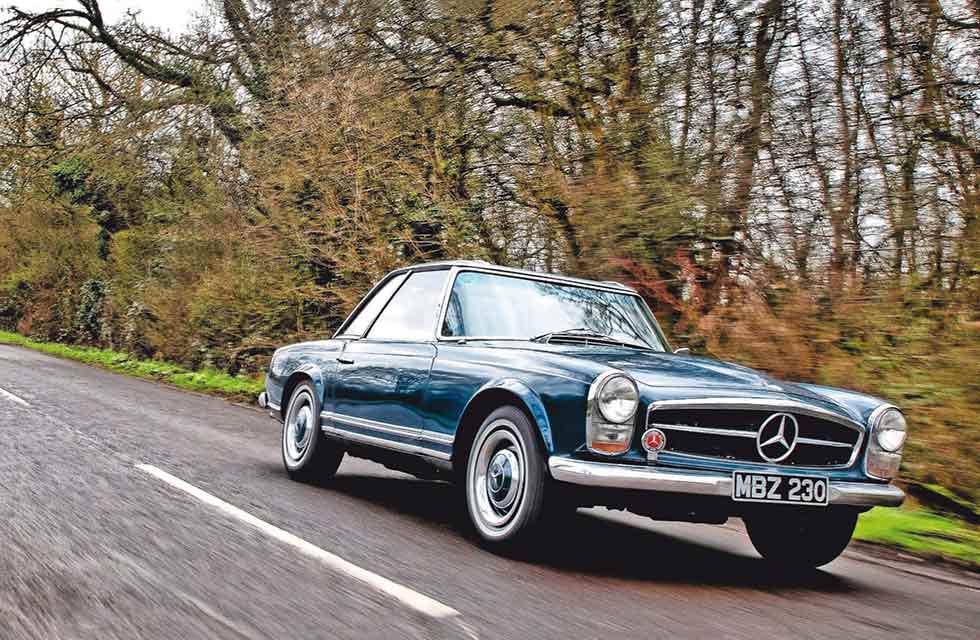
‘It’s even prettier than I remember,’ he remarks as we orbit the two-seater body. ‘The Pagoda is a very, very attractive shape.’ The removable hardtop roof stops Simon in his tracks. A popular optional extra, it was designed with a mild concave curve to increase strength without compromising cabin access, and remains the car’s most distinctive styling feature.
‘It isn’t a sports car, but then I spend my leisure time on a narrowboat!’
Likened to the pointed eaves of East Asian pagoda towers, the roof gives the model its enduring nickname. ‘I think a Pagoda has got to have the hood down or the hardtop fitted – and I do prefer it with the hardtop. It’s the style and the appearance of the thing.’
As a US-market car, this SL boasts another divisive styling feature – its sealed-beam headlights, whose separate round lamps differ from the full-length glass fitted in other markets. ‘I’ve seen them described as ugly but I disagree; I’m more surprised by the paint colour. From photos, I’d expected a navy blue.’ Owner James Mullen is on hand to explain. While this car began life finished in darker Midnight Blue – as the dashboard strip attests – it was repainted in aftermarket Bohemian Blue after an accident in the Nineties.
‘I do prefer it with the hardtop. It’s the style and the appearance of the thing.’
The complex hue underlines a legacy of use and appreciation, something James continues today and Simon immediately understands. ‘The more I speak with James, the more attractive this Pagoda becomes. It’s clear that he worships it and that reflects well on the SL. I’m happier with cars that get driven – like this one – and I’d rather be behind the wheel of a well-used 230 than an immaculate 280.’ One short conversation later, his wish is granted and Simon folds himself into the overstuffed driver’s seat.
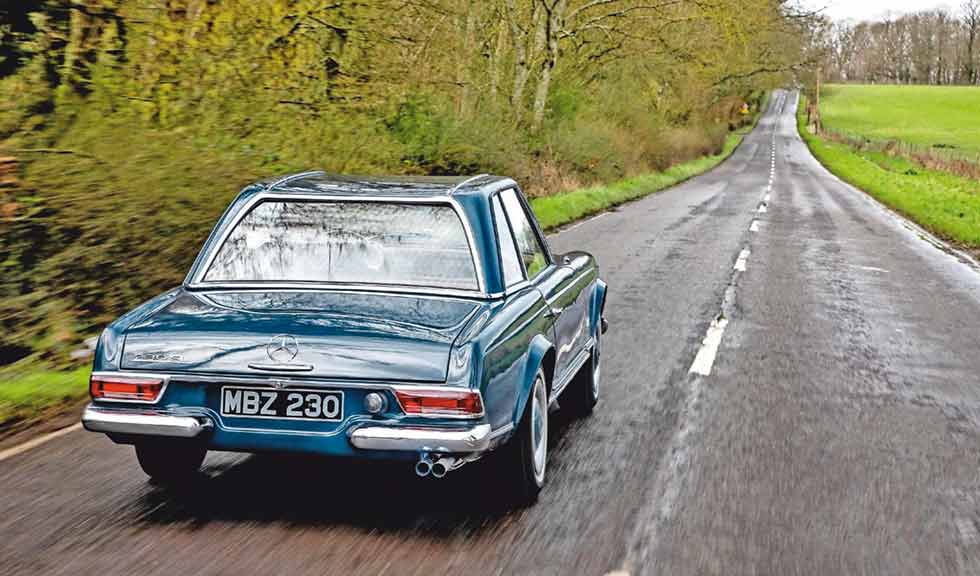
‘The gap between the chairs and the controls feels quite small, but that’s only because I’m taller than James and the seat can’t be adjusted until you’re inside,’ he laughs. ‘The steering wheel is huge, which is exactly as I thought, but overall it’s perfect. Everything is right there. Though the driving position is quite upright, the windows are deep and there’s masses of headroom with the hardtop, so it feels like you’re sitting lower than you really are.’ Only the low-backed seats offer a surprise. ‘Contrary to my expectations, they feel really soft and it’s clear that James has had them restored. They still feel supportive and they’re like comfortable armchairs.’
Surrounded by spotless cream and a minimalist dashboard, he takes a moment to appreciate the Mercedes’ design. ‘Look at the gorgeous rectangular instrument panel,’ says Simon, pointing to the glass rectangle that splits the tacho and speedometer. ‘It’s such a stylish thing, and it brings the dashboard together. This is the view you remember.’ Equally taken by the automatic reading light mounted in the glovebox lid, Simon is fast falling for the Pagoda.
A twist of the ignition key and the SL purrs to life. Simon edges out of the car park, beginning to process the differences between this roadster and his Mazda MX-5. ‘There’s a slight pause from the transmission as the car pulls away,’ he remarks as we queue to join the road. ‘There’s a lot of noise and not much initial movement. The brakes seem to take a lot of effort too… and we’re driving straight out onto Cranleigh high street.’ Thronged with parked cars on either side, the thoroughfare doesn’t make for the easiest introduction and our first metres are defined by understandable caution.
‘I’ve just finished a two and a half hour drive in my Mazda, where everything happens immediately,’ he says, ‘so it’s taking a few minutes to adjust to the Mercedes’ steering too. It doesn’t feel like it’s reacting or even connected at first, and the power assistance is obvious as soon you straighten up for the first time. The system is so light.’ Combined with the Pagoda’s near uninterrupted glasshouse, it’s soon helping him to place the SL with ease. ‘The visibility it offers is remarkable and means this isn’t a tricky car to wind through narrow streets.’
Familiarity might be growing but Simon still needs time to adjust to a left-hand drive car, since he’s never driven one on UK roads. Avoiding kerbs and potholes, the Pagoda hugs the centre line for a few miles before taking up a more natural position. ‘It does help that the Pagoda is an easy car to drive. My experience so far wouldn’t put me off buying a left-hand drive car myself and it feels like I’m starting to relax.’ Left elbow perched on the windowsill, Simon is the picture of composure as we float towards greener pastures.
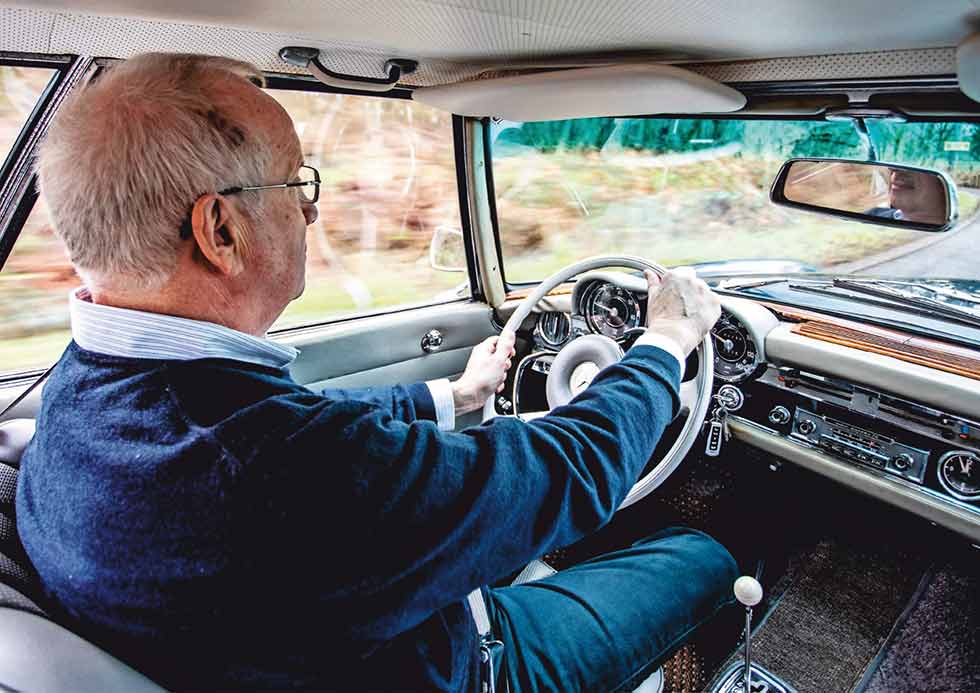
‘The steering isn’t too direct,’ he muses, ‘though I’m not turning so deliberately now and I’m beginning to feel some self-centring effect.’ That’s not the only advantage of treating the Pagoda with a more measured approach. As Simon loosens his grip on the wheel, it rewards with another improvement. ‘There’s feedback now too, and enough of it that you can tell where the SL is going and where it’s going to go.’ Special praise goes not to the system’s response, however, but the look of the unrestored wheel itself. ‘The rim is beautiful. It’s so narrow and the age cracks look like Raku pottery.’
A rest stop provides the opportunity to explore more of the Pagoda’s visual appeal; Simon hasn’t even left his seat before he spots an especially compelling feature – the door hinges. ‘On every other car I’ve seen, the stay is a rubber strip or has a flimsy construction. This has a solid metal bar and it’s how the roller ball moves between its catches that impresses me. The doors feel solid and beautifully engineered too. They need a firm shut.’
Other details appear as he lifts the bonnet and bootlid. ‘Everything is engineered on a massive scale and that’s underlined by the engine bay, where the components all look like they’ve been crafted from a massive stack of girders.’ Smaller details catch the eye in the boot. ‘There’s a little flap on the spare wheel so you can lift up the cover while keeping the ensconced tool roll in place; it’s those little details that I appreciate.’
Success in the 1963 Spa-Sofia-Liège established the Pagoda’s competition credentials but the 230 isn’t encouraging Simon to clip every apex, preferring a smoother and more relaxed approach. ‘I wouldn’t have a clue about the handling,’ he confesses, ‘though I’d hazard a guess it’s more like a saloon than a sports car.’ The brakes, meanwhile, provoke neither fear nor admiration. ‘The system works and causes me no grief, though there’s more delay than I expected after the initial pedal depression. It feels like a heavy little car and it does always stop.’
The suspension impresses more readily with its ride quality, even on the pockmarked B-roads leading out into tree-lined countryside. ‘There’s no shake or movement and the body certainly doesn’t keep bouncing after big compressions. I’m trying to avoid potholes and those I can’t miss don’t even register. The Pagoda is softer than I was expecting and more comfortable than anything I’ve driven for quite a while.’ Joined by fat 80-section tyres, the all-round coil springs keep the cabin serene as we crest ruts and rises.
Progress is underscored with a cultured hum that’s not quite what Simon expected. ‘I imagined the Pagoda would have a musical engine, somewhat like the straight-six in an E21 BMW 320i. The Mercedes does the job but there are lots of other sounds competing with the exhaust.’ James suggests that Simon work the engine harder to experience its aural highlights; he obliges as the road tracks straight through empty fields. ‘Open it up and the sound has a harder edge over 2500rpm,’ Simon confirms.
He continues, ‘The Pagoda wasn’t that quick in its day and it still isn’t now. It isn’t a performance car and that’s fine. I spend most of my leisure time on a narrow boat, so speed isn’t exactly a personal priority!’ Other aspects of the engine are more important to the driving experience, as Simon explains. ‘This isn’t a free-revving engine; the response isn’t instant yet it is linear and very smooth.’ Dropping our cadence, we return to what the SL does best, cruising through the next miles with leisure and luxury.
One final drive rounds out the day, and Simon noses the Pagoda in search of rural back roads. We soon find them on minor routes that skirt the Surrey Hills. Farmhouses punctuate the treeline, the Mercedes motoring through a scene that could fit the Sixties as well as it does today, but the tarmac is treacherous. Simon isn’t concerned. ‘It’s just as I expected – it’s a long-distance grand tourer and there’s not a rough edge to it.’ Taking advantage of the car’s well-defined edges and visibility, he navigates back to civilisation.
Only the transmission disrupts Simon’s flow, though he’s quick to attribute any misgivings to his own inexperience with automatic gearboxes. ‘It doesn’t change down when I expect and then it changes up when I don’t think it will, plus there’s still that lag when pulling away. For me, it’s the trickiest aspect of driving the Pagoda but I can’t say that it’s actually difficult. I’d mark it down to needing more time with the car to really understand the gearbox – and it wouldn’t put me off buying a Pagoda.’ Time is running short but the drive gets ever smoother over these final miles.
‘In a perfect world, I’d have preferred to keep the SL for longer and to drive it on roads I know well,’ Simon reflects as we glide back into Cranleigh. ‘That different environment would have allowed me to explore the car a little more.’ All the same, there are no regrets as he pulls into the parking spot where he met the Mercedes this morning. ‘I approached the List by asking myself what I’d want in my own garage, with the Pagoda and the Bristol sitting at the top. Today has scratched an itch and, funds permitting, I’d have one of my own. Perhaps I would have thought differently about the other cars I included – the Reliant Scimitar and an early Porsche 911 are on my list just to see what they’re like.’
Simon cracks a smile and it’s clear we’ve connected him with the right car, and one that could fit easily into his everyday life. ‘We’re getting out of the Pagoda now after perhaps three hours of driving and aches or pains simply aren’t present,’ he adds. ‘The SL is a narrow car too and that would be important to me, given three quarters of my driving is on small country lanes.’ Through rainstorms and missed turnings, today has shown Simon just how polished the Mercedes remains in those tricky conditions.
Fittingly for a model that’s often voted one of the greatest designs in automotive history, the final word goes to a visual artist. ‘William Morris said to “have nothing… that you do not know to be useful, or believe to beautiful.” Even just as a thing to look at, the Mercedes is gorgeous enough have in your life, and I could certainly use a Pagoda – in fact I couldn’t bear not to!’
Simon reckons the SL’s slender width would be an advantage on the lanes he drives regularly. Simon has high expectations of the Pagoda’s 148bhp straight-six engine. Owner James advises Simon to let it sing for the full aural experience. Four-speed has its own timetable Gauges offer clarity with style Inside, Simon is entranced by the Mercedes’ quality finish and details. Power steering is disconcertingly light until you get used to using it.
1966 Mercedes-Benz 230 SL W113
Engine 2306cc inline-six, sohc, Bosch mechanical fuel injection
Max Power 148bhp @ 5500rpm
Max Torque 145lb ft @ 4200rpm
Transmission Four-speed automatic, rear-wheel drive
Steering Recirculating ball, optional power assistance
Suspension
Front: independent, double wishbones, coil springs, torsion bar and telescopic dampers;
Rear: indepedent, swing axle with compensating spring, coil springs and telescopic dampers
Brakes Dual-circuit hydraulic with vacuum booster, discs front, drums rear
Weight 1290kg (2844lb)
Performance
Top speed: 121mph;
0-60mph: 10.7sec
Fuel consumption 28mpg
Cost new £3500
Classic Cars guide price £50k-£120k
SIMON’S DREAM DRIVE LIST
Bristol 411
‘So elegant. I used to call into the showroom and stare like a kid in a sweet shop!’
Mercedes ‘Pagoda’
‘Understated and competent, and surely a joy to drive long distances.’
Reliant Scimitar GTE
‘A car I always promised myself but have never got around to owning’
Alfa Romeo Spider
‘My friend used to run GTVs – I’ve wondered how this generation of Alfas drives,’ Lotus Elan +2 130 ‘I just know I’d like to drive one.’
Frazer Nash Le Mans Replica
‘Perfect from every angle and always the car I most want to take home from Goodwood.’
Rover P5B
‘The last of the real hairy-chested Rovers.’
Porsche 911 pre-impact bumper
‘One of the purest expressions and something of a duty call.’
Jaguar XK 150
‘A neighbour of my grandparents ran a succession of XKs in the Sixties – the noise was absolutely glorious.’
Caterham 7
‘I’m fed up of reading how fabulous they are when I’ve never driven one.’
SIMON DODD’S CAR CV
Droptops and classic coupés abound
LANCIA FULVIA COUPÉ SERIES 2
‘A 1300 with the dogleg gearbox and I loved it. No torque steer, so you didn’t know it was front-wheel drive, and a fabulous daily car.’
MG MIDGET 1275
‘A nightmare. The failed seat runners sent the passenger hurtling towards the windscreen, the single circuit brakes failed and I once span it near Beachy Head…’
LANCIA FULVIA COUPÉ SERIES 3
‘Bought because I loved my previous Fulvia, I ran this one until it rusted away. The first bits of Fiat interference were visible but I still adored it.’
MGF VVC
‘I had the MGF for four years, and it was both incredibly quick and incredibly comfortable. It had everything in the right place and a Hydragas suspension system.’
MAZDA MK-5 NA
‘I set out on the test drive from Tottenham and immediately became lost, so I just said I’d buy it. I ran out of miles on my classic insurance policy!’
MAZDA MX-5 NC
‘We had a road trip to Puglia planned and my wife insisted on air conditioning. I don’t set out to buy MX-5s but seem to end up with them.’

